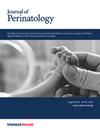两家社区医院产后患者和暴露婴儿的丙型肝炎感染筛查和护理连接,3 年随访 - 俄勒冈州,2019-2024 年。
IF 2.4
3区 医学
Q2 OBSTETRICS & GYNECOLOGY
引用次数: 0
摘要
目的:确定产后患者中丙型肝炎病毒 (HCV) 阳性率:确定产后患者丙型肝炎病毒(HCV)阳性率,为产前筛查建议、产后护理连接和婴儿 HCV 筛查做法提供参考:研究设计:对一家市区医院和一家郊区医院的产后患者进行方便抽样,对其进行丙型肝炎抗体快速指针检测:结果:在成功筛查的 2060 名产后参与者中,有 20 人(0.97%)有证据表明过去或现在感染过丙型肝炎病毒。有一人合并梅毒感染。中位随访 3.75 年后,12 名慢性 HCV 感染者中有 6 人(50.0%)完成了治愈治疗,20 名婴儿中有 9 人(45.0%)完成了筛查。发生了一起新生儿传播事件(5.8%):结论:与孕期常规筛查的其他病毒感染相比,HCV 感染在产后人群中更为常见。减少围产期 HCV 传播的工作重点应放在产后早期与治疗团队的联系、2-6 个月婴儿的早期筛查以及完成儿科检测上。本文章由计算机程序翻译,如有差异,请以英文原文为准。

Hepatitis C infection screening and connection to care among postpartum patients and exposed infants in two community hospitals, 3-year follow-up — Oregon, 2019–2024
Determine prevalence of hepatitis C virus (HCV) positivity among postpartum patients to inform prenatal screening recommendations, postpartum connection to care, and infant HCV screening practices. Convenience sample of postpartum patients at one urban and one suburban hospital to undergo rapid fingerstick testing for hepatitis C antibodies. Of 2060 postpartum participants successfully screened, 20 (0.97%) had evidence of past or current HCV infection. One co-infection with syphilis occurred. After a median follow-up of 3.75 years, 6 of 12 participants (50.0%) with chronic HCV infection completed treatment with cure, and 9 of 20 infants (45.0%) completed screening. One neonatal transmission event occurred (5.8%). HCV infection was more common in our postpartum population than other viral infections routinely screened for during pregnancy. Efforts to decrease perinatal HCV transmission should focus on early postpartum connection to treatment team, early screening in infants aged 2–6 months, and pediatric test completion.
求助全文
通过发布文献求助,成功后即可免费获取论文全文。
去求助
来源期刊

Journal of Perinatology
医学-妇产科学
CiteScore
5.40
自引率
6.90%
发文量
284
审稿时长
3-8 weeks
期刊介绍:
The Journal of Perinatology provides members of the perinatal/neonatal healthcare team with original information pertinent to improving maternal/fetal and neonatal care. We publish peer-reviewed clinical research articles, state-of-the art reviews, comments, quality improvement reports, and letters to the editor. Articles published in the Journal of Perinatology embrace the full scope of the specialty, including clinical, professional, political, administrative and educational aspects. The Journal also explores legal and ethical issues, neonatal technology and product development.
The Journal’s audience includes all those that participate in perinatal/neonatal care, including, but not limited to neonatologists, perinatologists, perinatal epidemiologists, pediatricians and pediatric subspecialists, surgeons, neonatal and perinatal nurses, respiratory therapists, pharmacists, social workers, dieticians, speech and hearing experts, other allied health professionals, as well as subspecialists who participate in patient care including radiologists, laboratory medicine and pathologists.
 求助内容:
求助内容: 应助结果提醒方式:
应助结果提醒方式:


